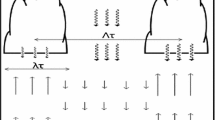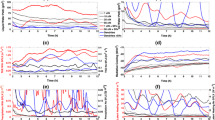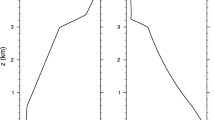Abstract
The effects on the convective boundary layer (CBL) of shading due to shallow cumulus clouds are investigated. The main question is to see whether clouds are able to produce secondary circulations by shading of the surface (dynamic heterogeneities) and how these dynamic heterogeneities interact with static heterogeneities in terms of the production of secondary circulations. Also the effects of cloud shadows on cloud-field characteristics are analyzed. The effects are studied using large-eddy simulations of a cloud-topped CBL with an idealized surface. Over a homogeneous surface, shadows trigger secondary circulations with different strengths depending on the solar zenith angle \(\vartheta \), with large \(\vartheta \) favouring the development of secondary circulations. Over a static heterogeneous surface with a simple striped pattern, the strength of secondary circulations is effectively reduced by dynamic heterogeneities at small \(\vartheta \). At large \(\vartheta \), however, the effect on secondary circulations depends on the orientation of the striped static heterogeneities to the shadow-casting direction of the clouds. The influence of shadows is only small if they are cast perpendicular to the striped heterogeneity, but if stripes and the shadow-casting direction are parallel, secondary circulations are reduced in strength also for large \(\vartheta \). Shadow effects on the cloud-field characteristics vary with \(\vartheta \) as well. The results show that small \(\vartheta \) favours the development of small clouds with a reduced lifetime while large \(\vartheta \) promotes the development of larger clouds with an extended lifetime compared to non-shading clouds.














Similar content being viewed by others
Notes
The code can be accessed under https://palm.muk.uni-hannover.de.
References
Avissar R, Schmidt T (1998) An evaluation of the scale at which ground-surface heat flux patchiness affects the convective boundary layer using large-eddy simulations. J Atmos Sci 55:2666–2689
Brown AR, Cederwall RT, Chlond A, Duynkerke PG, Golaz JC, Khairoutdinov M, Lewellen CD, Lock AP, Macvean M, Moeng CH, Neggers RAJ, Siebesma AP, Stevens B (2002) Large-eddy simulation of the diurnal cycle of shallow cumulus convection over land. Q J R Meteorol Soc 128:1075–1093
Couvreux F, Hourdin F, Rio C (2010) Resolved versus parametrized boundary-layer plumes. Part I: A parametrization-oriented conditional sampling in large-eddy simulations. Boundary Layer Meteorol 134:441–458. doi:10.1007/s10546-009-0456-5
Cuijpers JWM, Duynkerke PM (1993) Large eddy simulation of trade wind cumulus clouds. J Atmos Sci 50:3894–3908
Dawe JT, Austin PH (2012) Statistical analysis of an les shallow cumulus cloud ensemble using a cloud tracking algorithm. Atmos Chem Phys 12:1101–1119. doi:10.5194/acp-12-1101-2012
Gryschka M, Witha B, Etling D (2008) Scale analysis of convective clouds. Meteorol Z 17:785–791. doi:10.1127/0941-2948/2008/0345
Hadfield MG, Cotton WR, Pielke RA (1991) Large-eddy simulations of thermally forced circulations in the convective boundary layer. Part I: a small-scale circulation with zero wind. Boundary Layer Meteorol 57:79–114
Heus T, Seifert A (2013) Automated tracking of shallow cumulus clouds in large domain, long duration large eddy simulations. Geosci Model Dev 6:1261–1273. doi:10.5194/gmd-6-1261-2013
Hill TA, Choularton TW (1985) An airborne study of the mircophysical structure of cumulus clouds. Q J R Meteorol Soc 111:517–544. doi:10.5194/gmdd-6-2287-2013
Horn GL, Ouwersloot HG, Vilà-Guerau de Arellano J, Sikma M (2015) Cloud shading effects in characteristic boundary-layer length scales. Boundary-Layer Meteorol. doi:10.1007/s10546-015-0054-4
Hu YX, Stamnes K (1993) An accurate parameterization of the radiative properties of water clouds suitable for use in climate models. J Clim 6:728–741
Kasten F, Czeplak G (1980) Solar and terrestrial radiation dependent on the amount and type of cloud. Solar Energy 24:177–189
Letzel MO, Raasch S (2003) Large eddy simulation of thermally induced oscillations in the convective boundary layer. J Atmos Sci 60:2328–2341
Lohou F, Patton EG (2014) Surface energy balance and buoyancy response to shallow cumulus shading. J Atmos Sci 71:665–682. doi:10.1175/JAS-D-13-0145.1
Maronga B, Raasch S (2013) Large-eddy simulations of surface heterogeneity effects on the convective boundary layer during the litfass-2003 experiment. Boundary Layer Meteorol 146:17–44. doi:10.1007/s10546-012-9748-z
Maronga B, Gryschka M, Heinze R, Hoffmann F, Kanani-Sühring F, Keck M, Ketelsen K, Letzel MO, Sühring M, Raasch S (2015) The parallelized large-eddy simulation model (palm) version 4.0 for atmospheric and oceanic flows: model formulation, recent developments, and future perspectives. Geosci Model Dev 8(8):2515–2551. doi:10.5194/gmd-8-2515-2015, http://www.geosci-model-dev.net/8/2515/2015/
Martin GM, Johnson DW, Spice A (1994) The measurement and parameterization of effective radius of droplets in warm stratocumulus clouds. J Atmos Sci 51:1823–1842
Neggers RAJ, Jonker HJJ, Siebesma AP (2003) Size statistics of cumulus cloud populations in large-eddy simulations. J Atmos Sci 60:1060–1074
Ouwersloot H, Vilà-Guerau de Arellano J, van Heerwaarden C, Ganzeveld L, Krol M, Lelieveld L (2011) Layer segregation of chemical species in a clear boundary layer over heterogeneous land surfaces. Atmos Chem Phys 11:10,681–10,704
Patton EG, Sullivan PP, Moeng CH (2005) The influence of idealized heterogeneity on wet and dry planetary boundary layers coupled to the land surface. J Atmos Sci 62:2078–2097
Raasch S, Franke T (2011) Structure and formation of dust devil-like vortices in the atmospheric boundary layer: a high-resolution numerical study. J Geophys Res 116:D16120. doi:10.1029/2011JD016010
Raasch S, Harbusch G (2001) An analysis of secondary circulations and their effect caused by small-scale surface inhomogeneities using large-eddy simulation. Boundary-Layer Meteorol 101:31–59
Raasch S, Schröter M (2001) Palm—a large-eddy simulation model performing on massively parallel computers. Meteorol Z 10:363–372
Schumann U, Dörnbrack A, Mayer B (2002) Cloud-shadow effects on the structure of the convective boundary layer. Meteorol Z 11:285–294
Shen S, Leclerc MY (1995) How large must surface inhomogeneities be before they influence the convective boundary layer structure? A case study. Q J R Meteorol Soc 121:1209–1228
Sühring M, Maronga B, Herbort F, Raasch S (2014) On the effect of surface heat-flux heterogeneities on the mixed-layer top entrainment. Boundary-Layer Meteorol 151:531–556
Wapler K (2007) Der einfluss des dreidimensionalen strahlungstransportes auf wolkenbildung und -entwicklung. PhD thesis, Ludwig-Maximilians-Universität München, Munich
Wapler K, Mayer B (2008) A fast three-dimensional approximation for the calculation of surface irradiance in large-eddy simulation models. J Appl Meteor Climatol 47:3061–3071. doi:10.1175/2008JAMC1842.1
Wicker LJ, Skamarock WC (2002) Time-splitting methods for elastic models using forward time schemes. Mon Wea Rev 130:2088–2097
Williamson JH (1980) Low-storage Runge-Kutta schemes. J Comput Phys 35:48–56
Acknowledgments
All simulations were performed on the SGI Altix ICE at the North-German Supercomputing Alliance (HLRN), Hanover/Berlin. NCL (The NCAR Command Language (Version 6.1.2) [Software]. (2013). Boulder, Colorado: UCAR/NCAR/CISL/VETS. http://dx.doi.org/10.5065/D6WD3XH5.) was used for data analysis and visualization. We thank the two anonymous reviewers for their constructive and valuable comments that helped to improve the manuscript.
Author information
Authors and Affiliations
Corresponding author
Appendix 1
Appendix 1
The additional shading effect on the near-surface latent heat flux \(\textit{LE}\) has only a minor impact on the boundary-layer dynamics. In order to confirm this, we performed an additional simulation considering shading effects on \(\textit{LE}\) above a homogeneous surface at a solar zenith angle of \(\vartheta =60^\circ \). According to Lohou and Patton (2014) \(\textit{LE}\) is reduced by 50% on shaded surfaces, accounted for by
as in Eq. 6 for the sensible heat flux H. Figure 15a–c show the vertical profiles of \(\overline{u'^2}\), \(\overline{v'^2}\), and the liquid water content \(\overline{q_l}\), respectively, for a simulation with varying \(\textit{LE}\) due to shading and a reference simulation with constant \(\textit{LE}\). Modifying \(\textit{LE}\) due to shading results only in a minor increase of \(\overline{u'^2}\) and \(\overline{v'^2}\) inside the boundary layer. Thus, the contribution of a heterogeneous distribution of \(\textit{LE}\) to the formation of secondary circulations is only minor as compared to the effects of heterogeneities in H. Although heterogeneities in \(\textit{LE}\) enter into the buoyancy term, density changes due to changes in the humidity can be generally neglected for the small absolute humidity levels present in the simulations. The influence on the clouds is also very limited as shown by the small differences in the profiles of \(q_l\) (Fig. 15c) between the simulations. The cloud onset and development is mainly determined by the initial humidity profile, and because the surface \(\textit{LE}\) contributes little to the mean humidity profile, a heterogeneously distributed \(\textit{LE}\) has only minor effects on the cloud layer.
Profile of the variance of the a x-velocity component u, b y-velocity component v, and c the profile of the liquid water content \(q_l\) for simulations with the homogeneous surface with constant and varying \(\textit{LE}\) and \(\vartheta =60^\circ \). Profiles are averaged over the last 30 min of the simulation. Grey shaded areas represent the cloud layer
Rights and permissions
About this article
Cite this article
Gronemeier, T., Kanani-Sühring, F. & Raasch, S. Do Shallow Cumulus Clouds have the Potential to Trigger Secondary Circulations Via Shading?. Boundary-Layer Meteorol 162, 143–169 (2017). https://doi.org/10.1007/s10546-016-0180-7
Received:
Accepted:
Published:
Issue Date:
DOI: https://doi.org/10.1007/s10546-016-0180-7





